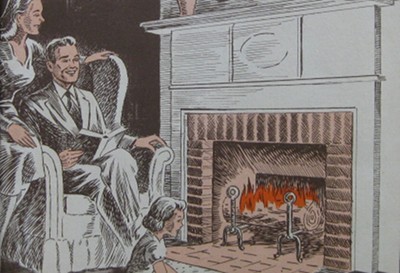
One of my favorite things about winter is spending time next to a warm and cozy fireplace fire. What’s more romantic than snuggling up to your gal in front of a glowing fire? And what’s more relaxing than coming home from a long day of work, sitting in your man chair, and unwinding next to a glowing hearth?
If you’ve never started a fire in a fireplace (and no, those automatic electric fireplace don’t count), then this guide is for you.
1. Make sure your chimney is clean and free of blockages. It’s always a good idea to get your chimney swept before you start lighting fires in it. Even if you haven’t used it, animal nests and old leaves can cause blockages that will result in a smoke-filled house. Call a chimney sweep to come check out your chimney. Of course, you should have done this already when you winterized your house.
2. Open the damper. I made the mistake of not opening the damper the first time I made a fire in a fireplace. The heater had gone out in our house, and we were in the middle of an ice storm. I tried being the big hero by starting up a cozy fire in the fireplace. I got the fire going, but it filled the entire house with smoke. Don’t be like me. Make sure to open the damper all the way if you want to avoid keeling over from smoke inhalation.
3. Prime the flue. If your chimney is built on the outside of your house, the chimney flue is probably cold. When you open the damper, the cold air in the flue will sink and come into your warm house. If you try to light a fire during this air sink, you’re going to end up with smoke coming into the house instead of up the chimney. To counteract the air sink, you need to prime the flue by warming it up. This is done by lighting a roll of newspaper and holding it up the damper opening for a few minutes. When you feel the draft reverse, you know the flue is primed, and you’re ready to start your fire. If you have a fireplace that has a gas pipe to supplement your wood burning, turn on the gas and light the pilot light without any wood in the fireplace. Your flue will warm up in a matter of minutes.
4. Develop an ash bed. Having a 1- 2 inch ash bed in your fireplace hearth will help insulate the fireplace and create hotter fires. If you’ve never built a fire in your fireplace before, this can be a problem. One quick fix is to take the ashes from your outdoor grill and place them in your fireplace to build the ash bed. While a small ash bed is good, too much ash is a bad thing. Make sure to clean the ashes out of your fireplace from time to time.
5. Build an “upside down†fire. Several fire-building methods exist, and all of them have their merits. If there’s a particular way you like to build a fire, by all means do it. But if you’re looking to build a clean burning fire that lasts for hours, try using the “upside down†fire lay.
Unlike traditional fire lays that require you to put tinder and smaller kindling at the bottom and larger fuel logs on the top, the upside down fire lay reverses the sequence. Start off by stacking your large fuel logs on the bottom of the fire grate. Stack smaller logs on top. Add a kindling layer (small twigs about the size of your pinky) on top of the stack. Top off the stack with bunched up newspaper balls and other tinder. Light the fire from the top. Because smoke won’t have to pass through the cold logs, the fire will burn cleaner. What’s nice about this arrangement, too, is that you don’t have to do much to keep it going.
With your cozy fireplace lit, it’s time to pick out a good book, make some hot chocolate, sink down into your leather man chair, and bask in the glow of the blazing hearth.


